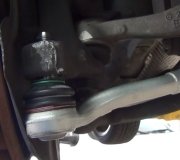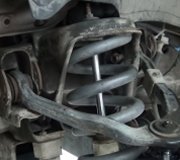Hi PeterMDR. Welcome to the forum. "Made in China" does not necessarily mean junk, but I have attended schools at the Moog facility and toured their research and development center and can tell you about the quality of their replacement parts. There is a reason parts can be made overseas and shipped here and still cost less than domestic parts, but if safety were an issue, distributors would stop selling them. They lose money every time they have to replace one for free.
While I wouldn't be terribly concerned with safety, I would expect the cheaper parts to require a little more work to make them fit, and they probably won't last as long as their higher-quality counterparts. For the record, I wouldn't expect original equipment parts to last as long as Moog parts either. Everyone who's been in the business for the last 20 years has replaced dozens, perhaps hundreds of Ford Escort outer tie rod ends that often separated leading to a crash. Any replacement tie rod end from ANY aftermarket manufacturer was better than the original part.
It was nice of your mechanic to agree to install your parts. Many won't for fear of being blamed if the parts fail. Also, this is like bringing your own food to a restaurant and asking them to cook it. But rather than assuming your mechanic is thinking "I told you so", I would be thinking, "thank goodness I didn't order those parts and risk my reputation by selling them to a friend / customer". First of all, you can't even be sure your new ball joints are causing the noise. Second, ANY new part can cause unexpected problems, otherwise they wouldn't need a warranty. When you pay the higher price the mechanic wanted to charge for his parts, you are paying in advance to help cover the labor cost of replacing a defective part. The mechanic made his profit up front. He can't charge you again when his part fails. You simply gambled that one of the new parts wouldn't fail. Had you won the bet, you'd be money ahead and you would have cost the mechanic just a tiny fraction of his potential profit. If it turns out you lost the bet, you aren't going to be out much more than if you had just let your mechanic sell you the parts. In fact, even by paying extra to get Moog parts from a discount supplier, you might STILL be a few bucks ahead in the long run. Plus, your mechanic will likely be thinking he has a future customer who "learned his lesson" and will be a better educated consumer at the next visit. "Learned a lesson" is much stronger language than I intended, but I think you understand my meaning. Educated consumers are much easier to work with as a team in diagnosing and repairing cars.
The easiest way to find the source of the noises is by using a tool called the "Chassis Ear". Many mechanics have never even heard of it and won't know what you're talking about. It is a set of six microphones that plug into a receiver you carry inside the car. You switch between them and listen with headphones while driving. You can zero in on the source of the noise by moving the microphones around. The new version of this tool has four wireless microphones and two with wires. This tool is available from the Mac Tools truck, part number ET6600. I'm sure it is also available from Matco, Cornwell, and Snapon. Cost is $199.99. If you want to try this yourself, ask at the local auto parts stores that rent or borrow tools to see if they have one.
Since you've already replaced all of the suspension parts that are likely to cause a rattle, I would suspect a problem with rusted, missing, or broken anti-rattle hardware on the front brake calipers or pads, especially if the rattle stops when applying light brake pedal pressure. Also, if you live in a state where they think road salt makes winter driving safer, inspect exhaust system clamps to see if any are rusted away and dangling on a pipe. Use a rubber mallet to bang on the catalytic converter too to see if the substrate inside is lose. That will cause more of a knocking or thumping sound. The exhaust clamps and brake pads will sound more metallic.
Caradiodoc
Thursday, May 20th, 2010 AT 2:37 AM


